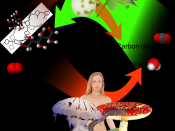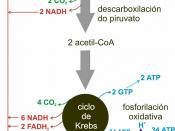Aerobic Respiration is a unique process that is an oxygen-dependent pathway of ATP formation. In this process potential energy is transferred from glucose (a monosaccharide) to phosphate bonds. This process is carried out in a series of reactions known as glycolysis, the Krebs cycle, and the electron transport system.
Aerobic respiration is an extremely important, life-sustaining process that is a key part of many organisms' survival. It produces ATP, which is an energy carrier. If this process were to stop working it would be life-threatening, and would eventually cause death. Another side effect of aerobic respiration shut-down would be that glucose would not be able to cross the cell membrane. This would cause a person to become very drowsy, and they would have a minimal amount of energy. If this problem was not corrected the person would most likely go into a coma, and death would be forthcoming.
A classic example of this is found in people with diabetes.
They need insulin injections, since their pancreas does not secrete an adequate amount, in order for glucose to cross their cell membranes. Insulin helps to regulate their condition, and without it, diabetics would not be able to live. Aerobic respiration is a very important process, not only in the human body, but also in the bodies of other organisms. If this process were to stop working, their would be no fresh supply of oxygen to our cells, and oxygen is the final elecron acceptor. Without aerobic respiration we would have not have sufficient energy for survival. Overall, the effects of aerobic respiration shutting down would be terminal.
Aerobic Respiration consists of three reaction stages. The initial stage is glycolysis, and during this phase glucose is partially broken down into pyruvate. The middle stage is known as the Krebs cycle, or the Calvin cycle. During this phase, enzymes cause pyruvate to break down completely into carbon dioxide and water.
NAD+ and FAD function as coenzymes during the first two stages of aerobic respiration.
This simply means they pick up hydrogen and electrons stripped from intermediates during both stages. While carrying electrons and H+ the two coenzymes are abbreviated NADH and FADH2. Very little ATP forms during glycolysis or the Krebs cycle. The large energy harvest occurs after NADH and FADH2 deliver their cargo to the electron transport system, which is the third, and final stage of respiration. In this stage the transport system serves as a type of machinery for a process referred to as electron transport phosphorylation, or chemiosmotic phosphorylation. This process sets up an H+ concentration and electric gradients which drive the formation of ATP. Oxygen accepts electrons at the end of this stage. This is a brief overview of the three stages that compose aerobic respiration.
The very first energy- releasing pathways evolved approximately 3.8 billion years ago. The conditions on Earth at this time were very different than they are today. The atmosphere had a minimal amount of free oxygen, therefore it can be surmised that the first pathways must have been anaerobic. This means that they could run successfully to completion without any oxygen. It is still possible for some cells in the human body to use an anaerobic route for short periods of time, when they are not receiving enough oxygen. However, humans' cells, like most others, use aerobic respiration, which is an oxygen-dependent pathway of ATP formation. This pathway is thought to have been derived from the anaerobic one, after free oxygen was added to the atmosphere, and overall it is much more efficient than its predecessor. Their is significant scientific evidence to back up this theory. Therefore, with this background in mind, we will take a closer look at the three individual stages of aerobic respiration.
Glycolysis occurs in the cytoplasm, outside of the mitochondrion. During the first steps of this stage, energy is required. Two ATP molecules each transfer a phosphate group to glucose, donating energy to it. This raises the energy level of glucose high enough to allow entry into the energy-releasing steps of glycolysis. The first energy-releasing step cleaves the activated glucose into two molecules of phosphoglyceraldehyde, which can be abbreviated as PGAL. The two PGALs are converted into an unstable intermediate, both of which allow ATP to form by giving up a phosphate group to ADP. The following intermediate in the sequence does the same thing. Four ATP form by substrate-level phosphorylation; this is the direct transfer of a phosphate group from a substrate of a reaction to some other molecule (ADP). As this occurs, NAD+ picks up electrons and hydrogen atoms released from each PGAL, becoming NADH. NADH will give up its cargo at a different reaction site, and will revert to NAD+. This basically means that it is reusable, like other coenzymes. This is the final step of glycolysis.
In preparation for the second stage of aerobic respiration, coenzyme A brings a 2-carbon acetyl and a 4-carbon oxaloacetic acid together, and a 6-carbon citric acid is formed. Coenzyme A is then released back into the matrix. During the second stage, known as the Krebs cycle, three functions occur in the mitochondrion. First, electrons and hydrogens are loaded into NAD+ and FAD. This results in NADH and FADH2.
After this occurs, two ATP molecules are produced through substrate-level phosphorylations. Lastly, the Krebs cycle intermediates are rearranged into oxaloacetate.
This must be regenerated, since cells have only so much, in order for the cycle to keep going.
The electron transport system makes up the third stage of aerobic respiration.
This system occurs in the mitochondrial membrane. Hydrogen is brought in by NAD and FAD. NADH + H+ passes two hydrogen atoms to the system. Next electrons travel back across the membrane and pick up H+, from the dissociation of water. These two H+ are brought back and dropped off. This same process repeats, and two more H+ are dropped off. Electrons again travel back across the membrane and join with 1/2 O2 + H2O (forms). H+ then moves through the protein channel and energy is used to cause a phosphate to add to ADP, forming ATP, through chemiosmotic phosphorylation. Free oxygen keeps the ATP production constant. It withdraws spent electrons from the ends of the transport systems and then combines with H+ to form water. This marks the end of the electron transport system, and, in turn, aerobic respiration.
In summary, two ATP molecules form in both glycolysis and the Krebs cycle.
This gives us a total of four ATP. Thirty-two ATP form in the electron transport system! This, with the four from the first two stages, gives us a total harvest of approximately thirty-six ATP. We know that ATP equals energy, and it is obvious that aerobic respiration plays a huge role in the production of energy. This process is key to our survival because without it we would not have ATP production, and without ATP production we would have no energy. An organism cannot survive without energy.
Therefore, it can be concluded that aerobic respiration is one of the most important processes in our body, and although it is very complex when examined closely, it's overall purpose is simple : without aerobic respiration we would not be here.


